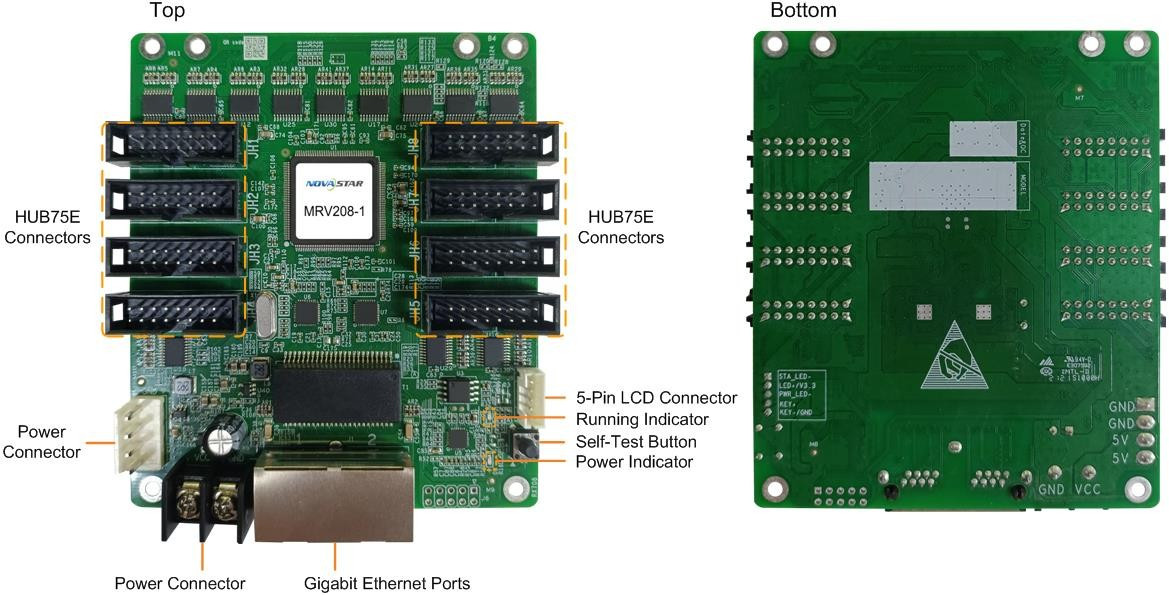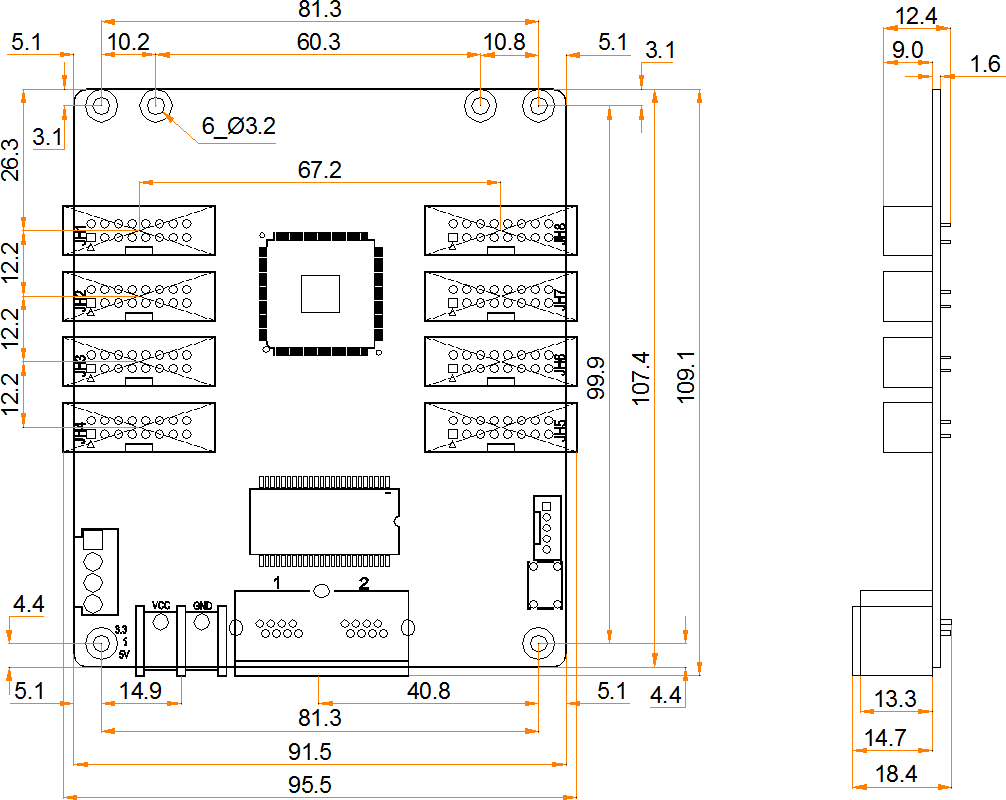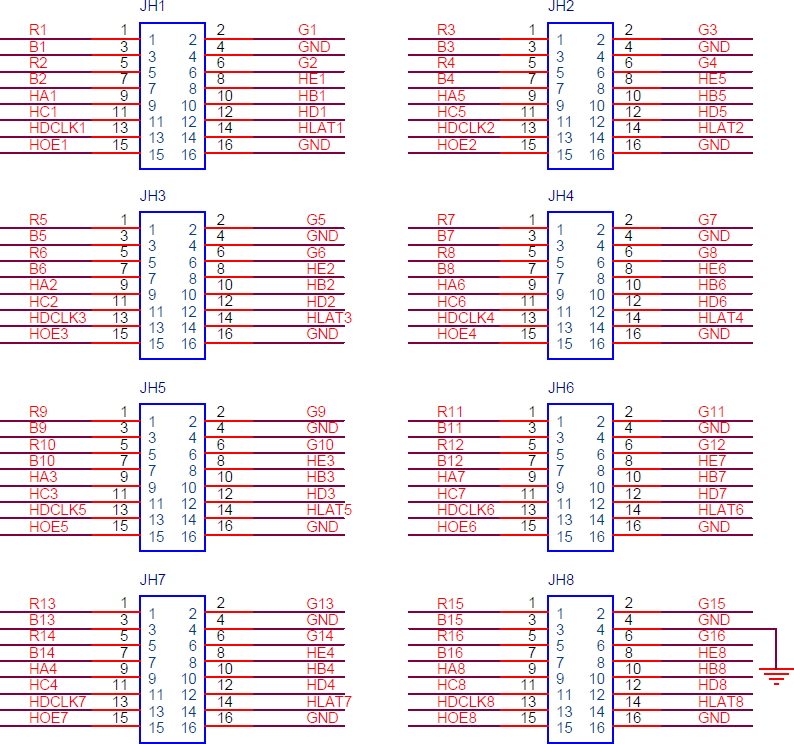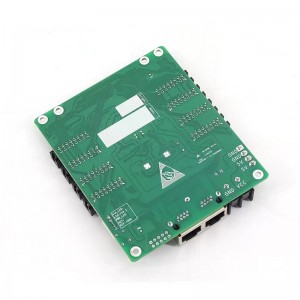Novastar MRV208-1 Receiving Card For LED Screen Cabinet
Introduction
The MRV208-1 is a general receiving card developed by Xi’an NovaStar Tech Co., Ltd. (hereinafter referred to as NovaStar). A single MRV208-1 supports resolutions up to 256×256@60Hz. Supporting various functions such as pixel level brightness and chroma calibration, quick adjustment of dark or bright lines, and 3D, the MRV208-1 can significantly improve the display effect and user experience.
The MRV208-1 uses 8 standard HUB75E connectors for communication, resulting in high stability. It supports up to 16 groups of parallel RGB data. Thanks to its EMC compliant hardware design, the MRV208-1 has improved electromagnetic compatibility and is suitable for various on-site setups.
Certifications
RoHS, EMC Class A
Features
Improvements to Display Effect
⬤Pixel level brightness and chroma calibration Work with NovaStar’s high-precision calibration system to calibrate the brightness and chroma of each pixel, effectively removing brightness differences and chroma differences, and enabling high brightness consistency and chroma consistency.
Improvements to Maintainability
⬤Quick adjustment of dark or bright lines
The dark or bright lines caused by splicing of modules and cabinets can be adjusted to improve the visual experience. The adjustment can be easily made and takes effect immediately.
⬤3D function
Working with the sending card that supports 3D function, the receiving card supports 3D image output.
⬤Quick uploading of calibration coefficients The calibration coefficients can be quickly uploaded to the receiving card, improving efficiency greatly.
⬤Mapping function
The cabinets can display the receiving card number and Ethernet port information, allowing users to easily obtain the locations and connection topology of receiving cards.
⬤Setting of a pre-stored image in receiving card The image displayed on the screen during startup, or displayed when the Ethernet cable is disconnected or there is no video signal can be customized.
⬤Temperature and voltage monitoring
The receiving card temperature and voltage can be monitored without using peripherals.
⬤Cabinet LCD
The LCD module of the cabinet can display the temperature, voltage, single run time and total run time of the receiving card.
Improvements to Reliability
⬤Bit error detection
The Ethernet port communication quality of the receiving card can be monitored and the number of erroneous packets can be recorded to help troubleshoot network communication problems.
NovaLCT V5.2.0 or later is required.
⬤Firmware program readback
The receiving card firmware program can be read back and saved to the local computer.
NovaLCT V5.2.0 or later is required.
⬤Configuration parameter readback
The receiving card configuration parameters can be read back and saved to the local computer.
⬤ Loop backup
The receiving card and sending card form a loop via the primary and backup line connections. If a fault occurs at a location of the lines, the screen can still display the image normally.
⬤Dual backup of configuration parameters
The receiving card configuration parameters are stored in the application area and factory area of the receiving card at the same time. Users usually use the configuration parameters in the application area. If necessary, users can restore the configuration parameters in the factory area to the application area.
Appearance
⬤Dual program backup
Two copies of firmware program are stored in the application area of the receiving card at the factory to avoid the problem that the receiving card may get stuck abnormally during program update.

All product pictures shown in this document are for illustration purpose only. Actual product may vary.
Indicators
| Indicator | Color | Status | Description |
| Running indicator | Green | Flashing once every 1s | The receiving card is functioning normally. Ethernet cable connection is normal, and video source input is available. |
| Flashing once every 3s | Ethernet cable connection is abnormal. | ||
| Flashing 3 times every 0.5s | Ethernet cable connection is normal, but no video source input is available. | ||
| Flashing once every 0.2s | The receiving card failed to load the program in the application area and is now using the backup program. | ||
| Flashing 8 times every 0.5s | A redundancy switchover occurred on the Ethernet port and the loop backup has taken effect. | ||
| Power indicator | Red | Always on | The power supply is normal. |
Dimensions
The board thickness is not greater than 2.0 mm, and the total thickness (board thickness + thickness of components on the top and bottom sides) is not greater than 8.5 mm. Ground connection (GND) is enabled for mounting holes.

Tolerance: ±0.3 Unit: mm
To make molds or trepan mounting holes, please contact NovaStar for a higher-precision structural drawing.
Pins

|
Pin Definitions (Take JH1 as an example) |
|||||
|
/ |
R1 |
1 |
2 |
G1 |
/ |
|
/ |
B1 |
3 |
4 |
GND |
Ground |
|
/ |
R2 |
5 |
6 |
G2 |
/ |
|
/ |
B2 |
7 |
8 |
HE1 |
Line decoding signal |
|
Line decoding signal |
HA1 |
9 |
10 |
HB1 |
Line decoding signal |
|
Line decoding signal |
HC1 |
11 |
12 |
HD1 |
Line decoding signal |
|
Shift clock |
HDCLK1 |
13 |
14 |
HLAT1 |
Latch signal |
|
Display enable signal |
HOE1 |
15 |
16 |
GND |
Ground |
Specifications
| Maximum Resolution | 512×384@60Hz | |
| Electrical Parameters | Input voltage | DC 3.8 V to 5.5 V |
| Rated current | 0.6 A | |
| Rated power consumption | 3.0 W | |
| Operating Environment | Temperature | –20°C to +70°C |
| Humidity | 10% RH to 90% RH, non-condensing | |
| Storage Environment | Temperature | –25°C to +125°C |
| Humidity | 0% RH to 95% RH, non-condensing | |
| Physical Specifications | Dimensions | 70.0 mm × 45.0 mm × 8.0 mm |
|
Net weight |
16.2 g
Note: It is the weight of a single receiving card only. |
|
| Packing Information | Packing specifications | Each receiving card is packaged in a blister pack. Each packing box contains 80 receiving cards. |
| Packing box dimensions | 378.0 mm × 190.0 mm × 120.0 mm | |
The amount of current and power consumption may vary depending on various factors such as product settings, usage, and environment.
Do you have any MOQ limit for led display order?
A: No MOQ, 1pc for sample checking is available.
How do you ship the goods and how long does it take to arrive?
A: We usually ship by sea and by air. It usually takes 3-7 days by air to arrive, 15-30 days by sea.
How to proceed an order for led display?
A: First: Let us know your requirements or application.
Second: We will provide you the best solution with suitable product according to your requirements and recommend.
Third: We will send you the complete quotation with detailed specifications for your needed, also send you more detailed pictures of our products
Fourth: After received the deposit, then we arrange the production.
Fifthly: During the produce, we will send the product test pictures to customers, let customers know every production process
Sixth: Customers pay the balance payment after confirmation of the finished product.
Seventh: We arrange the shipment
What about the lead time?
A: Sample needs 15 days, mass production time needs 3-5 weeks depends on the quantities.
What the software your company uses for your product?
A: We mainly use the software of Novastar, Colorlight, Linsn and Huidu.
Can I have a sample order for Led display ?
A: Yes , we welcome sample order to check and test quality. Maxed samples are acceptable.
What about the lead time ?
A: Our regular production time is 15-20 normal days against advance payment, for huge quantity, please check with our sales manager.
Do you have any MOQ limit for Led display order ?
A: Module sample is accepted in our company, so we don’t have MOQ request for led displays.
What is the warranty for your led display?
A: The standard warranty is 2years, while it is possible to extend the max. warranty to 5years with extra cost.
How to maintenance led screen?
A: In usually every year to maintenance led screen one time, clear the led mask, checking the cables connection, if any led screen modules fail, you can replace it with our spare modules.
Data reconstruction and storage technology
LED electronic display has good pixels, no matter day or night, sunny or rainy days, LED display can let the audience see the content, to meet people's demand for display system.
At present, there are two main ways of organizing memory groups. One is the combination pixel method, that is, all pixel points on the picture are stored in a single memory body; the other is the bit plane method, that is, all pixel points on the picture are stored in different memory bodies. The direct effect of multiple use of storage body is to realize a variety of pixel information reading at a time. Among the above two storage structures, the bit plane method has more advantages, which is better in improving the display effect of LED screen. Through data reconstruction circuit to achieve the conversion of RGB data, the same weight with different pixels is organically combined and placed in the adjacent storage structure.













